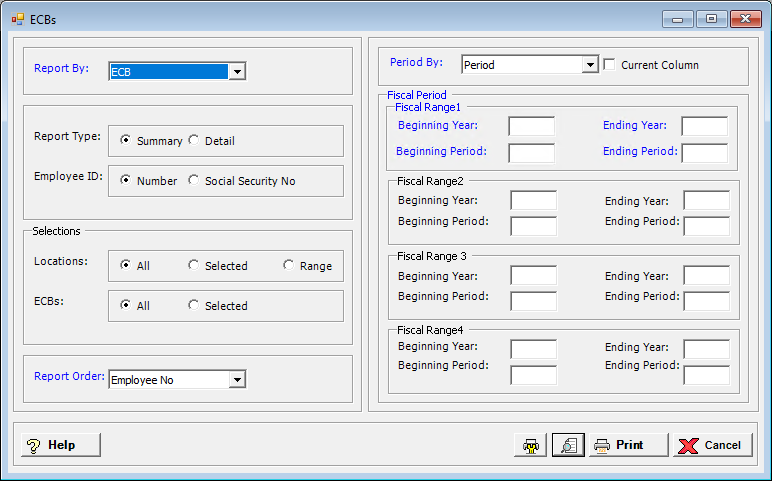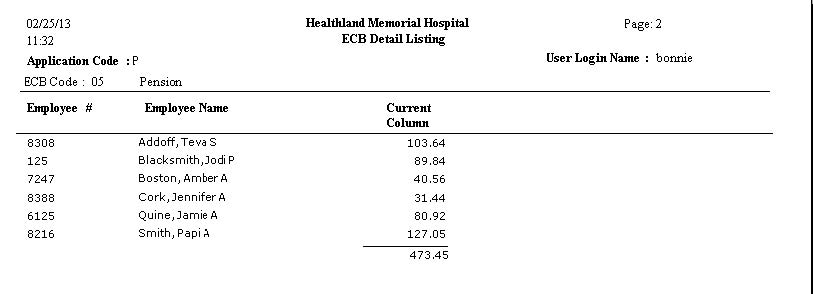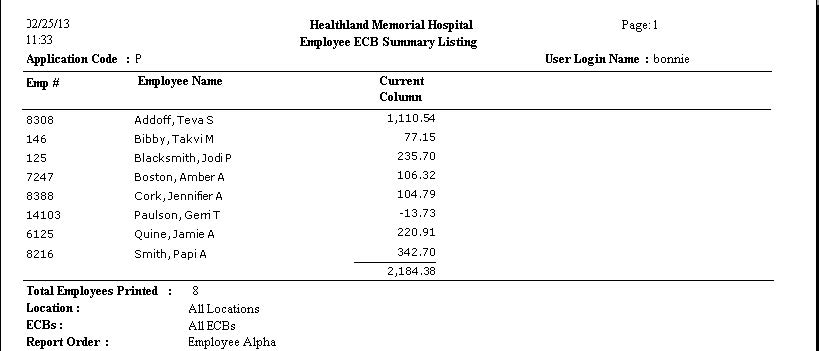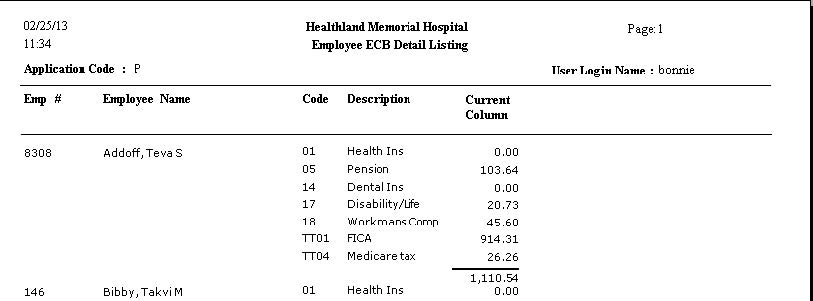
The ECBs report shows either totals for each ECB for the time periods selected, or a list of each employee with the selected ECBs. Up to four periods can be compared.
The ECB Summary Listing shows each selected ECB and the totals for the periods or dates selected.
The ECB Detail Listing shows each ECB on a separate page with the totals for each employee with that ECB.
The Employee ECB Summary Listing shows the total amount of ECBs for each employee.
The Employee ECB Detail Listing shows each employee with a list of their ECBs and totals for the period/date selected.
To access the ECBs window, go to Payroll > Reports > ECBs. [+]
In the Report By field, use the drop-down list to select the option to base the report. Choose from the following options:
ECB - (default) To show ECB amounts by ECB code and description.
Employee - To show ECB amounts by employee ID and name.
In the Report Type field, select the option that determines the type of report to print. Choose from the following options:
Summary - (default) To print a report including totals only.
Detail - To print a report including employee and ECB amounts.
In the Employee ID field, select the option that determines the employee identification to include in the report. Choose from the following options:
Number - (default) To print the report by employee number.
Social Security No - To print the report by the employee's SSN.
In the Locations and ECBs fields, specify the locations and ECBs to include in the report. Choose All (default), or choose Selected or Range (as available) to specify which ones to include. See Reporting/Printing Functions for detailed information on using the Selected and Range options.
In the Report Order field, use the drop-down list to select how to sort the detailed report. Choose from the following options:
Employee No - (default) To print in alphanumeric order by employee number.
Employee Alpha - To print in alphabetical order by employee name.
Department - To print by location and department.
In the Period By field, use the drop-down list to select the option that determines the pay periods to include the report. Choose from the following options:
Period - (default) To include pay periods based on the selected fiscal time period.
Check Date - To include pay periods based on the selected range of check dates.
Period Ending Date - To include pay periods based on the selected range of period ending dates.
Check the Current Column box to print amounts for the current unposted payroll (if it exists) in the first column. If checked, the Range1 date fields are disabled as no date range is required.
Choose from the following options based on the Period By selection.
If reporting by Period, enter the time period to include in the report. Enter the first fiscal year of the range in the Beginning Year field, and the last fiscal year of the range in the Ending Year field. Enter the first fiscal period of the range in the Beginning Period field, and the last fiscal period of the range in the Ending Period field. Enter up to 4 ranges of fiscal year/periods to compare.
If reporting by Check Date, enter a range of check dates to include in the report. Enter the first date of the range in Beginning Date field, and the last date of the range in the Ending Date field. Use the drop-down calendar in each field to select the date. The ending date must be equal to or greater than the beginning date. Enter up to 4 ranges of dates to compare.
If reporting by Period Ending Date, enter a range of period end dates to include in the report. Enter the first date of the range in Beginning Date field, and the last date of the range in the Ending Date field. Use the drop-down calendar in each field to select the date. The ending date must be equal to or greater than the beginning date. Enter up to 4 ranges of dates to compare.
Click the Preview button (located to the left of the Print button) to view the ECB Listing in the Report Viewer, or click Print to print the report to the designated printer. See Reporting/Printing Functions for detailed information on using the Printer Settings and Print Preview buttons.
Click Cancel to exit.
ECB Summary Listing Example

ECB Detail Listing Example

Employee ECB Summary Listing Example

Employee ECB Detail Listing Example
